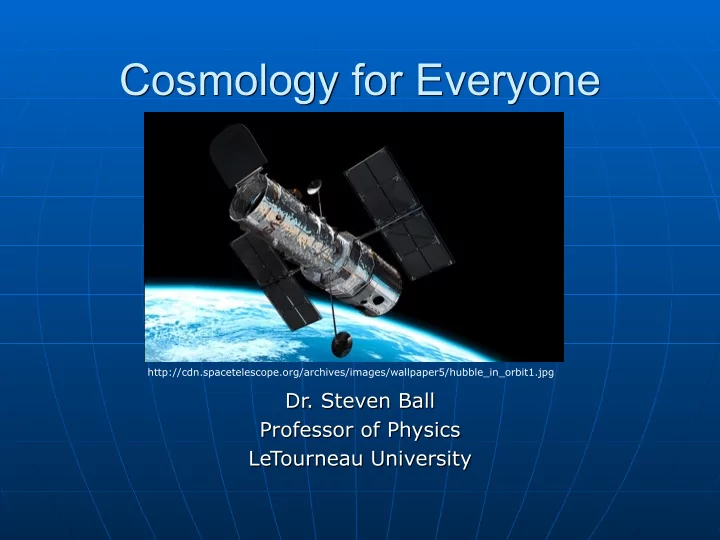

Cosmology for Everyone http://cdn.spacetelescope.org/archives/images/wallpaper5/hubble_in_orbit1.jpg Dr. Steven Ball Professor of Physics LeTourneau University
Hubble Telescope eXtreme Deep Field
Modern Cosmology Begins Albert Einstein (1879-1955) ■ Special Relativity (1905) ■ General Relativity (1915): ■ matter-energy <=> space-time www.universetoday.com/56612/einsteins-general- relativity-tested-again-much-more-stringently/ Philosophical Bias to expect www.science4all.org/wp-content/uploads/2013/05/Gravity.jpg Contrast to Newtonian Gravity, static cosmos (unchanging) ■ objects follow curvature of space Had to modify equations to induced by matter yield static cosmos solution
Expanding Universe Alexander Friedmann (1888-1925) ■ Solved Einstein’s Field Equations ■ (correcting algebraic mistake and eliminating cosmological constant) Predicted expanding universe from 3 ■ solutions: open (expands forever), closed (will collapse), and flat Size of universe en.wikipedia.org/wiki/File:Aleksandr_Fridman.png Time
Great Debate of 1920 Astronomers Harlow Shapley vs. Heber Curtis ■ Are the spiral nebulae part of the Milky Way Galaxy or ■ island universes far beyond the Milky Way? Inconclusive debate due to lack of observational evidence. ■ en.wikipedia.org/wiki/File:Andromeda_Galaxy_(with_h-alpha).jpg
Expanding Universe Confirmed Edwin Hubble (1889-1953) ■ Using Mt. Wilson Observatory 100 ■ inch reflector telescope (1920) By 1925 confirmed that the ■ Andromeda nebula lies far beyond the Milky Way and is also a vast galaxy of stars There are billions of galaxies ■ stretching out in space billions of light years away from us. By 1929 confirmed that the further a ■ galaxy is from us, the faster it recedes from us. www.tumblr.com/search/mount+wilson+observatory
Hubble’s Law Expansion of Universe seen in slight ■ change in wavelengths of spectral lines in receding galaxies (redshift z = Δλ / λ ) Hubble’s Law: Recesion Velocity = ■ Constant times Distance (v = H d) en.wikipedia.org/wiki/File:Redshift.png Using present data we now know H o = 72±1 km/s/Mpc. Age of the universe is then (assuming constant expansion) T = d/v = 1/H o = 13.6 billion yrs From Filippenko & Riess, Phys.Rept. 307 (1998) 31-44
The Big Bang Theory George Gamow (1904-1968) ■ Used physics to extrapolate universe ■ back in time to when it was very small and exceedingly hot and dense! (1948) Proposed that Hydrogen and Helium ■ were synthesized during the first few minutes of “Big Bang” expansion, but www.aip.org/history/cosmology/ideas/ could not account for heavier elements! images-ideas/gamow-b1.jpg With Ralph Alpher & Robert Herman ■ predicted hot radiation background then at 10 mill K, released when temp drops to 3000 K, eventually cools to only 5 K with continued expansion today. Big Bang
Steady State Theory Fred Hoyle (1915-2001) ■ Denounced “Big Bang” (1949) ■ en.wikipedia.org/wiki/File:Fred_Hoyle.jpg Offered Steady-State Theory of Cosmology – continuous creation outofthisworldsc663a.weebly.com/the-steady-state-theory.html
Cosmic Microwave Background Discovered by accident by ■ Bell Lab scientists Arno Penzias and Robert Wilson (1965) map.gsfc.nasa.gov/media/ContentMedia/990045b.jpg Proved Hot Origin of Universe! map.gsfc.nasa.gov/media/ContentMedia/990015b.jpg
Horizon Problem – Too Smooth! ■ Solution: Brief Inflationary Expansion – Alan Guth 1980 web.mit.edu/physics/images/faculty/ guth_alan.jpg astronomy.swin.eud.au/cms/imagedb/albums/userpics/bigbang2.jpg ■ Predicts Slight Non-Uniformity of CMBR from Quantum Fluctuations
Search for Variations in Cosmic Microwave Temperature Galaxy Formation implies radiation background could not be ■ entirely uniform – hotter spots needed to initiate it Original Expectations: variation in T / T = 0.001 ■ With Cold Dark Matter present (another discussion) revised ■ expections: variation in T / T = 0.00001 Cosmic Background Explorer (COBE 1992) ■ upload.wikimedia.org/wikipedia/commons/thumb/ en.wikipedia.org/wiki/File:COBE_cmb_fluctuations.gif a/af/Cobe_vision1.jpg/230px-Cobe_vision1.jpg
Discovery of Accelerating Expansion of Universe! (1998) 2 Teams: Supernova Cosmology Project and High Z Supernova Search Team find unexpected result: expansion increasing! http:// From Conley, et al ApJS (2011), 192, 1 http://www.physast.uga.edu/~rls/1020/ch22/22-18.jpg Rather than slowing down (decelerating) the universe is expanding faster today than in the past! “Dark Energy”
History of Universe Revised http://daedalus.as.arizona.edu/~gwalth/Astr170B1/Lectures/images/22_18_Figure-Anno.jpg Dark Energy now dominates Energy Density of Universe, implying universe will continue expanding faster & faster!
Wilkinson Microwave Anisotropy Probe (WMAP 2003) http://map.gsfc.nasa.gov/media/101080/101080_7yrFullSky_WMAP_320W.jpg Cosmology Becomes a Precision Science!
Angular Size of Fluctuations Establishes Geometry of Universe http://map.gsfc.nasa.gov/media/070950/070950b.jpg
WMAP Data reveal a Flat Geometry for the Universe! http://csp.res.in/ICSP-WEB/Docs/Pop_cd/Material/Quiz/cosmos/wmap-findgeometrysmg.gif ■ Total Mass-Energy Density is precisely the Critical Density: 71% Dark Energy, 24% Dark Matter, only 4.6% Ordinary Matter ■ Establishes Age of Universe: 13.7 billion years
Galaxy Formation Dark Ages end after around 400 million years, when large ■ halos of dark matter spawn growth of stars and galaxies upload.wikimedia.org/wikipedia/commons/thumb/6/6f/CMB_Timeline300_no_WMAP.jpg/350px-CMB_Timeline300_no_WMAP.jpg
Cosmology begs Bigger Questions ■ Does the vast scale of our cosmos imply that we are insignificant? ■ Are we just a cosmic “accident”? ■ Or does the vast and elegant universe point to a purposeful plan? ■ Can an ancient religious faith in a transcendent God and humanity as the apex of creation be reconciled to what we see in modern cosmology today?
Recommend
More recommend